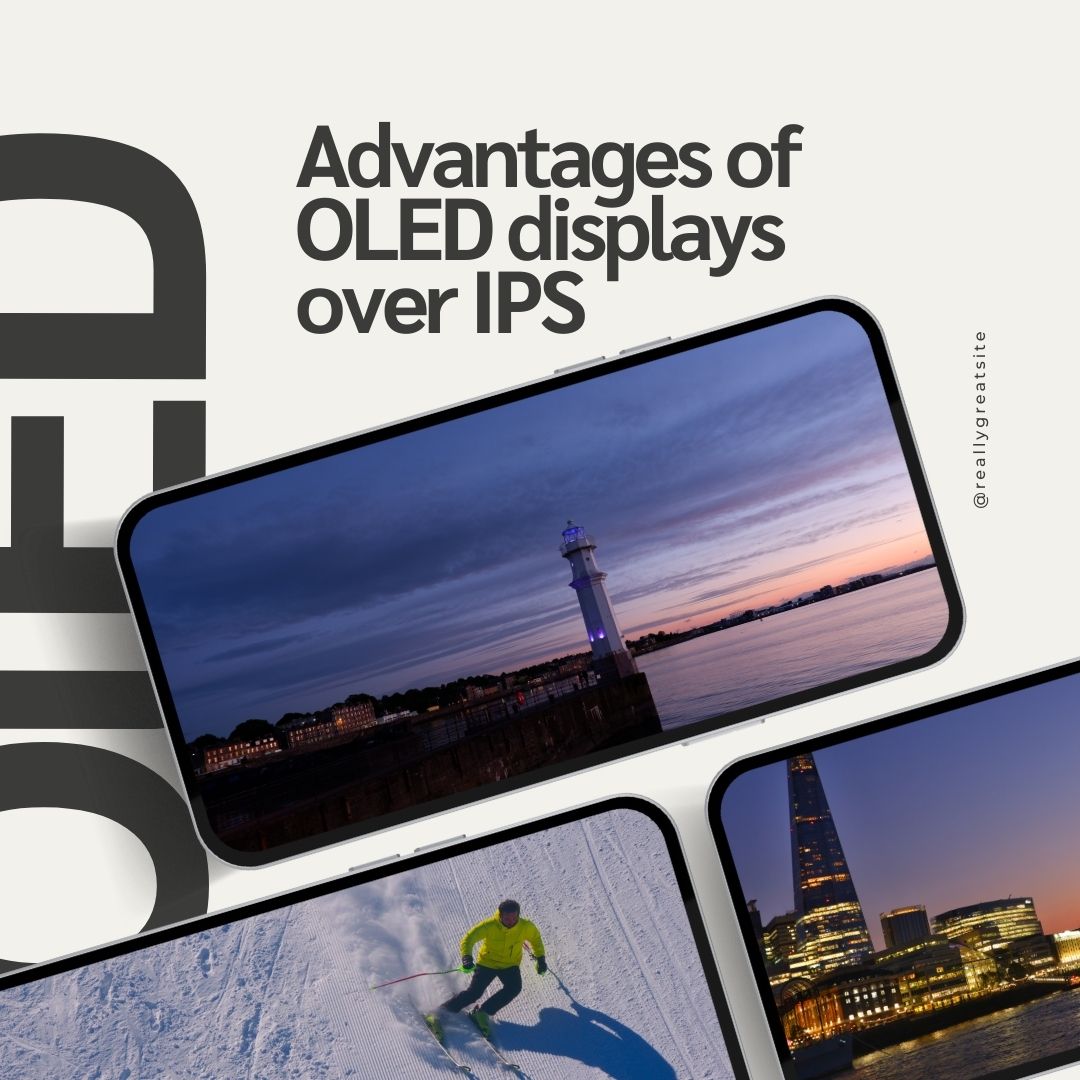Introduction:
In today’s world, we can see various types of displays all around us. These displays come in the form of our cellphones, tablet, television and PC or laptop. We work on these displays. And we use them for our entertainment and educational purposes too. As far as display types are concerned, there are two key technologies with us. The first one is the OLED displays and the second one is the IPS displays.
Each of these displays has different and unique features. But OLED displays have turned out to be more premium and better than the IPS display. Don’t you know what are the advantages of the OLED displays over the IPS?. You need not to worry. In this article, I will be providing you with all the advantages of the OLED displays over the IPS displays. So what are you waiting for?. Let’s begin the show!.
OLED Displays:
The term OLED is an acronym of Organic Light-Emitting Diode. OLED displays work on a special type of self-emissive technology. In this technology, every pixel emits its own light and they do not need a backlight. This technology is very different from the technology of the traditional displays. The traditional displays need a backlight for enlightening all of their pixels. The OLED displays produce light directly from the organic compounds. And due to this reason, the OLED displays produce deeper true black color, infinite contrast ratios and vivid and vibrant colors.
OLED displays are nowadays in use in premium smartphones, high end TV devices, and unique products like foldable phones. We use it in them because these displays are very thin, durable and flexible. Some devices that are using OLED technology nowadays include the iPhone 15 Promax, Samsung S24 Ultra, and LG OLED TVs.
IPS Displays:
IPS is the acronym of the In-Plane Switching technology. These displays work on the principles of a new type of LCD technology. This technology uses a backlight to illuminate all of the pixels in the whole screen. The IPS displays are designed in such a way that they allow better color reproduction and wider viewing angles.
IPS displays are very good in their color accuracy and stability. These displays consume more power than OLED displays. They use this power in keeping the backlight bright. The IPS displays are in use in professional monitors, budget smartphones and mid range TV sets. Some devices that are using IPS displays nowadays include the iPad 9th generation, Iphone 11 and Dell Ultrasharp Monitors.
Differences between OLED Displays and IPS Displays:
The OLED and IPS displays both have their own unique features and advantages. But both of them are different from each other in many things. Some common differences between OLED displays and IPS displays are listed below;
| Features | OLED Displays | IPS Displays |
| Backlight | No backlight | needs a backlight |
| Pixel Structure | Self-emissive pixels | Liquid crystal pixels illuminated by backlight |
| Black Levels | Perfect blacks | Dark gray levels |
| Contrast Ratio | Infinite | High, but not infinite |
| Color Accuracy | Wide color gamut, accurate colors | Good color accuracy, but can be affected by viewing angles |
| Response Time | Faster response times | Slower response times |
| Viewing Angles | Good viewing angles, but can suffer from color shift at extreme angles | Wider viewing angles with consistent color reproduction |
| Power Consumption | Generally lower power consumption | Higher power consumption due to backlight |
| Pricing | Typically more expensive | Generally more affordable |
Advantages of OLED Displays Over IPS Displays:
OLED displays have more advantages over the IPS displays. Some of the key advantages are listed below:
Deeper Blacks and Higher Contrast Ratios:
One of the main features that give advantage to OLED displays over the IPS display is that the OLED displays produce true black colors. In OLED panels, each pixel produces and emits its own light. And when a pixel is in need of displaying black, then it simply turns off. This thing creates a deeper true black color. This results in infinite contrast ratios too. In contrast, IPS displays are not like that. These displays rely on their backlighting. So even when the display is black, then this backlighting causes some light to bleed through. This thing leads to washed-out dark areas. And due to it, the IPS displays are unable to produce deeper black color. Their contrast ratio is lower too due to that reason.

Better Color Accuracy and Vibrancy:
Another advantage of the OLED displays over the IPS displays is their superior color accuracy. The colors appear more vivid and vibrant on OLED screens because each pixel on it emits its own light. This thing favors us in many beneficial activities like photo editing, video production and watching movies. IPS displays are not that bad either. They are famous for their good color reproduction. But their colors are not that much vivid and vibrant. The IPS displays are improving and are still in the game. But the OLED displays take it a step further with their richer and more saturated colors.

Faster Response Times:
Another advantage of the OLED displays over IPS displays is that their response time is far higher than the response time of the IPS displays. The response time of a screen means how quickly a pixel can change from one color to another color. The faster response time of display is very important for gaming and for fast moving content.
The OLED displays totally outperform IPS displays in this matter. OLED panels can have a response time as low as 0.1 milliseconds. While IPS displays can not hit that. They usually have the response times of around 1 to 5 milliseconds. The faster response time of OLED screens greatly helps us in games and content consumption. This is the reason why modern esports gamers like to play on devices like Iphone 15 Pro Max and Samsung S24 Ultra.
Thinner and Lighter Design:
OLED displays are thinner and lighter than IPS displays. It is because OLED displays do not need a backlight. This thing allows manufacturers to create slimmer devices. Thanks to the OLED displays, the reason due to which the modern smartphones, TVs, laptops and cell phones are getting slimmer. OLED panels are more flexible than the IPS panels. This thing has enabled us to make curved or foldable phones. In contrast, IPS displays are not like that. They need a backlight. And that backlight makes them more bulkier and less flexible in terms of design.

Power Efficiency:
Another important advantage of OLED displays is that they are energy efficient. It is because each pixel on an OLED screen is emitting its own light. So the display consumes less power when it is showing a darker image or scene. For instance, when your phone screen is mostly black, then your OLED panels will drastically reduce the power consumption. It is not like this in IPS displays. In IPS displays, the backlight is constantly on. And due to it, they consume more power regardless of the image being displayed. This thing makes the OLED technology more power-efficient than IPS. This can extend the battery life of your portable devices too.
Improved Eye Comfort:
The OLED displays are more comfortable for your eyes as compared to the IPS displays. OLED displays are self-emissive. And this quality reduces its need for intense backlighting. So they put less strain on your eyes. Additionally, they produce a true deeper black color. And their contrast ratio is also higher. And all these things create a more visually soothing experience, especially in low light conditions. This is not the same in IPS displays. These displays are not self-emissive. They produce less black colors. And their contrast ratio is low. So they are not that much comfortable for your eyes.

Flexible and Curved Designs:
One of the most advanced and innovative features of OLED displays is that they are flexible. You can bend them, fold them and curve them. And it will not affect their performance at all. This quality has opened up new possibilities for screen designing. Due to this, innovative products such as foldable smartphones and curved TVs are in the market. IPS displays are not like that. They are rigid. They are dependent on their backlight. So they cannot offer the same level of flexibility and durability. Bend them and you will be missing your display the next second.
Future-Proof Technology:
Finally, OLED displays are indeed a more future-proof technology. While it is not the same for IPS. Soon, OLED is gonna take all the market. Many leading manufacturers are investing huge amounts in OLED technology. It is being used across a wide range of devices, from smartphones to high-end TVs. The future is of OLED. As the technology advances, you will see more advancements in the OLED technology. While the IPS will gradually disappear from the screen.
Conclusion:
Both OLED and IPS displays have their unique features and advantages. But OLED displays have an edge over the IPS. OLED displays offer a range of advantages over IPS displays. These advantages include the deeper black color, better color accuracy, wider viewing angles, faster response times, thinner design and better power efficiency. While IPS displays are still in use in many affordable devices and professional monitors, the OLED technology is rapidly grooming. And in the future, it is going to overtake the whole industry.
FAQS:
Q: What does OLED stand for?.
Ans: The term OLED stands for Organic Light-Emitting Diode.
Q: What does IPS stand for?.
Ans: The term IPS stands for the In-Plane Switching displays.
Q: Which one among OLED and IPS displays are more power efficient?.
Ans: OLED displays are more power efficient than IPS displays.
Q: Which Iphone model has an IPS display?.
Ans: Iphone 11 and Iphone XR have IPS displays.







